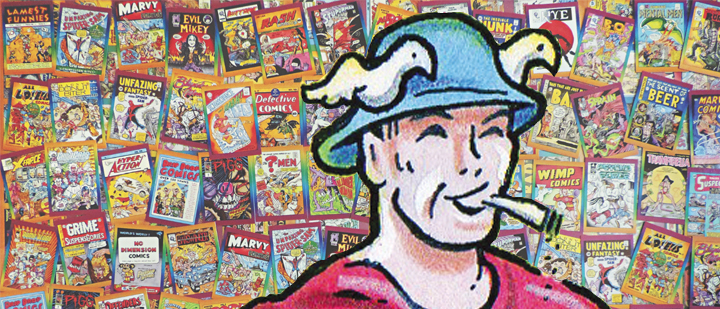
A nod to history in the age of gimmicks
By Mark Voger, illustrator
Defective Comics Trading Cards
You could call it a case of “When experience meets opportunity.”
But really, it was more like dumb luck.
In January 1993, I was a guest artist at a comic-book convention held at Jacob Javits Center in New York City. I was flogging my forthcoming comic book, Defective Comics #1 (Comic Zone Productions). It was a “flip” book with parodies of DC’s The Brave and the Bold #28 (1960) and Marvel’s Fantastic Four #1 (1961). Fellow Silver Age geeks know well the significance of these books.
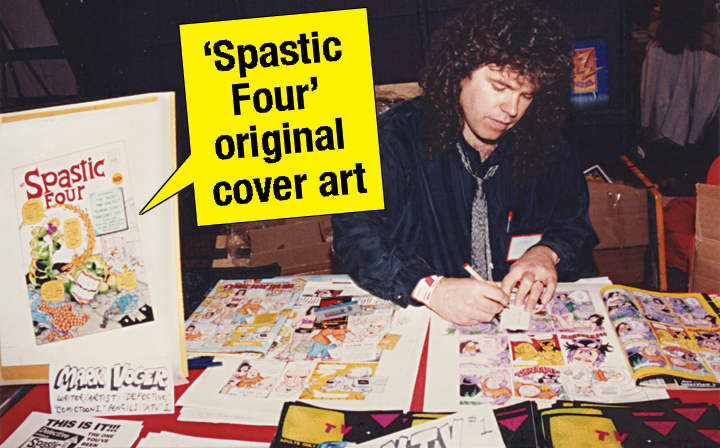
I had the original artwork for the FF cover parody, which I called The Spastic Four, on a little stand at my table. (It was color art on Bristol board.) A fella walked by who represented Connecticut-based Active Marketing International, publisher of Hustler and James Dean trading cards. Here’s what I wrote about that encounter in a 1993 press release:
“A lot of little kids would laugh at it (the Spastic Four art) as they walked by, which I figured was a good sign. Then a grownup laughed at it — Bill Evans of Active Marketing. He just threw his card on the table, then a few Hustler cards, and asked me if I felt like doing a whole series based on the cover art I was displaying. … He had a strong vibe about it from the beginning.”
Within 20 minutes, we hammered out a “handshake” agreement to produce a trading card series of 50 cover parodies. (A proper contract would soon follow.) I wanted to name the set Kooky Klassics, and exclusively draw parodies of vintage covers. Bill’s notion was to name the set after my comic book: Defective Comics Trading Cards. (Yeah, yeah, I know — it wasn’t a particularly clever or original title. But it did the job.)
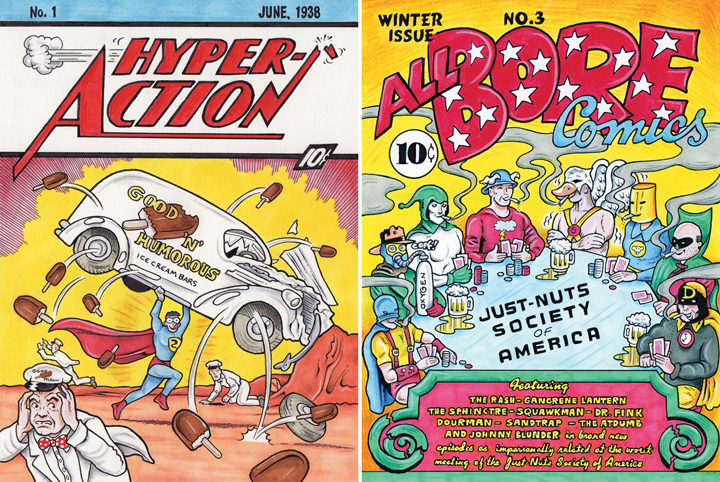
First, as a professional courtesy, I needed to speak with Rich Rankin, founder of Comic Zone Productions, to tell him I was doing a trading-card series using the same title as the comic book he green-lit. I had no idea how he would react. “That’s great, Mark. Good luck,” he told me. I’ll never forget that, onset dementia notwithstanding. Rich added that an identically titled trading-card series might be good publicity for the comic book.
So I set about creating 48 cover parodies — 48, not 50, because we decided to use the existing flip-book parodies as two of the trading cards. I was directed by Active to draw two-thirds vintage covers and one-third contemporary covers. That seemed lop-sided, but in the long run, it worked like a charm. The set looked more modern, hence more accessible to the kids, while maintaining a hefty nod to the history of the medium.

For the most part, I chose the subjects, though Active had more input into the ’90s books parodied. They loaned me copies of those books which, of course, I did not own, Silver Age nut that I am.
I drew the spoofs at double their reproduction size, again on Bristol board, using ink, marker, colored pencils and goauche highlights. Parody subjects included Famous Funnies #1 (1934, first regularly published comic book); Action Comics #1 (1937, first Superman); Detective Comics #28 (1939, first Batman); Marvel Comics #1 (1939, Marvel’s predecessor); All-Star Comics #3 (1940, first superteam); Captain America Comics #1 (1941, first Captain America); some noteworthy 1950s EC books; Silver Age milestones; all the way up to Frank Frazetta‘s Vampirella #1 (1969).

Then came the modern stuff: X-Force #1, Harbinger #1, Spawn #1, Pitt #1, Bloodshot #1, etc. The cards were numbered in chronological order with the exception of Superman #75, the famous (or infamous) “Death of Superman” edition of 1992. That book seemed to encapsulate the entire era, with its editorial stunt of Supes’ “death” (which, of course, didn’t stick) and its abundance of polybagged premiums — the poster and the obit and the armband. It seemed fitting to end the set on that somber-slash-cynical note.
(Gawd, but this was a lot of work, all on top of my full-time gig as a writer-designer for newspapers. To conserve precious minutes, I perfected the practice of shampooing and shaving at the same time. One hand scrubs your scalp, the other runs a razor over your face and neck. Risky, but a time-saver.)
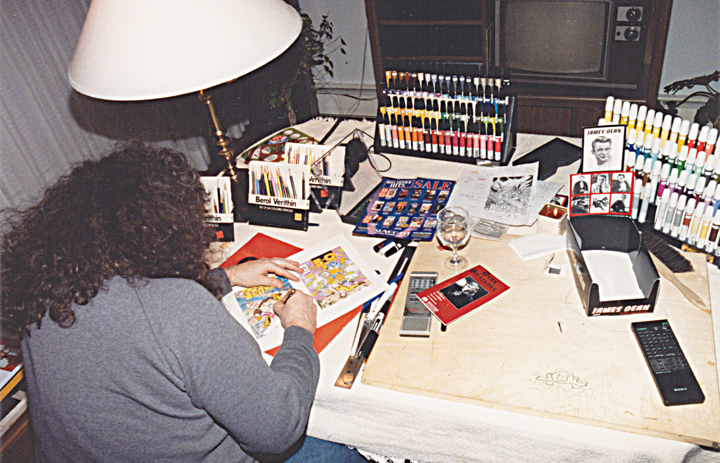
FYI, I didn’t write the copy on the card-backs, nor did I design them. I was just too busy doing the artwork itself. The reproduction was terrific — good scans, good “registration” (color printing alignment). I wish the covers on each card had been cropped as “true bleeds” — that is, no color borders — but you can’t have everything.
The year 1993 was the apex of gimmicks in comic-book publishing. Defective Comics Trading Cards would not buck this trend. There were pack-inserted foil cards (in gold or silver), a sweepstakes entry card, and a then-popular item known as Autograph Cards. (I signed 100 Autograph Cards for each of the 50 cards in the set, totalling 5,000.)
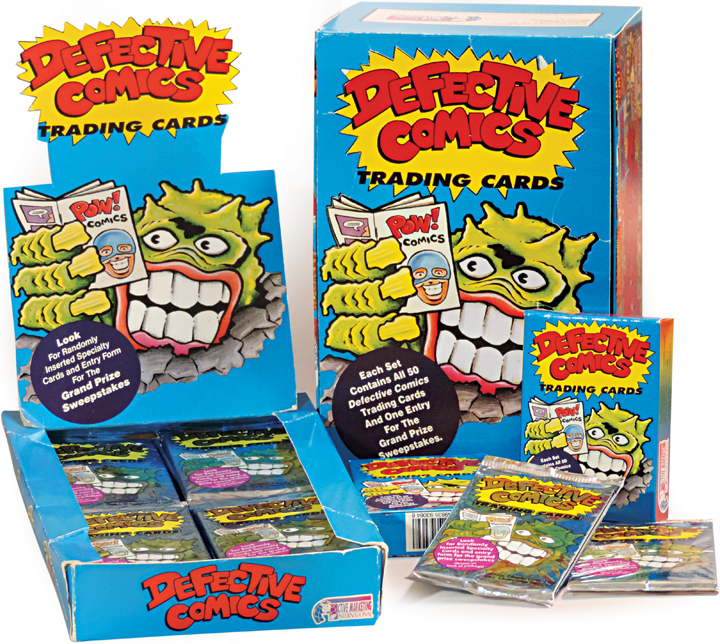
The copy on the back of the Autograph Cards, attributed to me, stated: “These cards are embossed with the Active Marketing International Corporate Seal in order to insure their collectibility and your valuable investment.”
This was somewhat counter to my thinking. I was not enamored of the “speculator” mentality — wherein comics are regarded as “investments,” as opposed to something you read and are entertained by. My wish was that some kid would love my cards the way I loved Norm Saunders‘ Batman cards when I was 8. And, try as I might, I could not detect even a hint of embossing. Anyway, I signed the cards and moved on in the hopes that Defective would find an audience.
When Active asked if I had an idea for yet another gimmick, I cooked up a sort of twist on the Autograph Card. Click below to read all about it. Ooh … cliffhanger!
P.S.: Since going public with my side of the story in Back Issue #120 (June 2020), the Sketch Card community has begun to take notice.